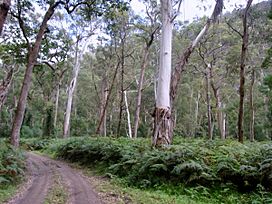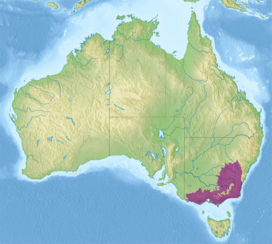Southeast Australia temperate forests facts for kids
Quick facts for kids Southeast Australia temperate forests |
|
|---|---|

Eucalypus woodland in Wadbilliga National Park
|
|

Ecoregion territory (in purple)
|
|
| Ecology | |
| Realm | Australasian |
| Biome | temperate broadleaf and mixed forests |
| Borders | |
| Geography | |
| Area | 272,200 km2 (105,100 sq mi) |
| Country | Australia |
| States | Australian Capital Territory, New South Wales, and Victoria |
| Conservation | |
| Conservation status | Critical/endangered |
| Protected | 12.6% |
The Southeast Australia temperate forests is a special natural area, or ecoregion, found in southeastern Australia. It's a type of temperate broadleaf and mixed forests, which means it has many trees that lose their leaves in cooler weather, mixed with others that stay green. This ecoregion covers the cooler lowland forests at the southern end of the Great Dividing Range. The plants here change from wet forests near the coast to drier forests and woodlands further inland.
Contents
Where are the Southeast Australia Temperate Forests?
This amazing ecoregion covers most of the state of Victoria. It also reaches into southeastern New South Wales. You'll find it on the flat coastal areas and on the drier western slopes of the Great Dividing Range. It wraps around the Australian Alps montane grasslands, which are much higher up, over 1,200 meters (about 3,900 feet) high.
The northern part of this ecoregion is in the area where the Murray River flows. This is north of the Great Dividing Range and the Grampians. The southern part, south and east of these ranges, has rivers like the Yarra, Macalister, Thompson, and Snowy. These rivers flow into the Bass Strait or the Tasman Sea.
This ecoregion shares its borders with other natural areas. To the northeast, it meets the Eastern Australian temperate forests. To the north, you'll find the Southeast Australia temperate savanna. The Murray-Darling woodlands and mallee are to the northeast, and the Naracoorte woodlands are to the east.
The ecoregion includes six main natural areas, called IBRA bioregions. These are the New South Wales South Western Slopes, South East Coastal Plain, South East Corner, South Eastern Highlands, Southern Volcanic Plain, and Victorian Midlands. Melbourne, Australia's second-largest city, is the biggest city located within this ecoregion.
What Plants Grow Here?
The Southeast Australia temperate forests are home to many different plant groups. These include wet and dry sclerophyll forests, which have tough, leathery leaves. There are also eucalypt woodlands, temperate rainforests, grasslands, and dense heath areas. You can also find special plants along the coast and near rivers.
Wet Sclerophyll Forests
Wet sclerophyll forests are common between the coast and the Great Dividing Range. This range separates these humid forests from the drier ones further inland. The trees here are usually medium height, with smaller shrubs underneath. Eucalypts are the main trees. Some common types are brown stringybark (Eucalyptus baxteri), manna gum (E. viminalis), messmate stringybark (E. obliqua), and mountain grey gum (E. cypellocarpa). Brown stringybark grows in less fertile soil, while messmate stringybark is found in richer soils.
Box-Ironbark Forests
Box-ironbark forests are found in the low hills between the Great Dividing Range and the drier plains. The main trees here are grey box (Eucalyptus microcarpa), yellow gum (E. leucoxylon), and red ironbark (E. sideroxylon).
Eucalypt Woodlands
Eucalypt woodlands are in the drier inland areas. These are open forests with medium-sized trees, where 10 to 30 percent of the ground is covered by tree leaves. Common trees include grey box, yellow box (Eucalyptus melliodora), and Blakely's red gum (E. blakeleyi). The ground is mostly covered by grasses, like Themeda triandra, with only a few shrubs.
In the Geelong area and on the Southern Tablelands of New South Wales, there are treeless plains made of basalt rock. These areas are mostly covered by spear grasses, such as Stipa scabra and S. bigeniculata.
What Animals Live Here?
This ecoregion is home to many native mammals. These include the famous koala (Phascolarctos cinereus), the southern tiger quoll (Dasyurus maculatus maculatus), and the long-nosed potoroo (Potorous tridactylus). You might also spot the tiny feathertail glider (Acrobates pygmaeus) and the eastern pygmy possum (Cercartetus nanus).
Some animals are found only in the coastal parts, like the mainland swamp antechinus (Antechinus minimus maritimus) and the white footed dunnart (Sminthopsis leucopus). The smoky mouse (Pseudomys fumeus) and the agile antechinus (Antechinus agilis) are almost only found here. The Leadbeater’s possum (Gymnobelideus leadbeateri) lives only in the wet eucalypt forests of the Victorian Central Highlands.
Protected Areas and Conservation
About 12.6% of this ecoregion is protected. This means these areas are set aside to keep nature safe. Some of the protected places include Croajingolong National Park, Snowy River National Park, Wadbilliga National Park, and Murramarang National Park in the South East Corner. Also protected are Grampians National Park in the Victorian Midlands, Great Otway National Park southwest of Melbourne, and Mount Imlay National Park.

